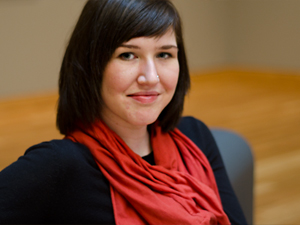*A forgotten artist’s work can help us understand ourselves, says U graduate*
“I am a detective of sorts,” Annika Johnson says. “And I find clues in paintings, documents, and letters that tell me about who the artist was that made them and when, where, and why they made them.”
Johnson, who received her art history degree from the U this past May and is now applying to graduate schools across the country, did undergraduate research on Clara Mairs—a little known Minnesota artist from the depression era. Johnson describes Mairs’ work as “playful yet psychological, monumental yet humble” and says she not only helped activate the state’s modern and avant-garde art movements but also was central in the early development of arts education in St. Paul.
Recently, Annika Johnson talked about her research.
Q&A with Annika Johnson
Why did you do research on Clara Mairs?
I love her paintings and prints, which led me to find out more information about her. As I dug in to her life and work, her enigmatic status in the St. Paul art world of the 1920s-60s made her even more intriguing.
Why is this important?
Clara Mairs worked during a time of great change in the United States. Her work parallels two world wars, advancements in women’s rights, and the introduction of modernism to artists working in the United States. Artists were making a conscious effort to wean themselves from the artistic values of the mother countries and use art as an embodiment of a uniquely American identity. … The digital revolution is much underway today just as the industrial revolution was in Clara’s time, and today’s artists express an anxiety and the search for identity, as did Clara’s generation in the 1920s-40s. Through history we can understand ourselves, whether as similar or different from the past.
How did you discover your creative path?
I had a penchant for historical fiction when I was little, and my collection of exhibition catalogs started when I was about 12 years old. Art and artist biographies always interested me, especially seeing the development of an artist’s body of work over a lifetime and how that growth parallels movement of thought beyond the art world. I had a very inspiring art history teacher at my high school … who made the topic approachable and who gave me confidence in my attempts to understand art objects. It wasn’t until my sophomore year of college that I realized there was career potential in the field of art history and at that point I switched majors from geography to art history.
What do you love most about what you do?
I love meeting with collectors and discussing their collections with them: why they collect, how they came to collect Clara Mairs’ work, and the insight they have on their collections. … Researching Clara Mairs is in some regards a collaboration with the collectors who have been dedicated to tracking down and maintaining her work—much of which has disappeared or been forgotten over the past 100 years. … The thrill of the hunt is an obsession of mine. … To track down her prints I have had to look into Minnesota State Fair art pavilion pamphlets from the 1930s and ’40s, exhibition files from various museums, and her personal papers located at the Minnesota Historical Society. The occasional 60-year-old brochure will list the owner’s name of a painting—and I go from there. Finding the smallest clue can lead to the biggest finds.
Why the University of Minnesota?
The U of M’s location in the heart of Minneapolis appealed to me as the city has an incredible arts scene. Over the course of my undergraduate experience I learned that the school is very involved with the community in which it sits, and I began to appreciate the student’s community initiatives and insights. As a [public university] the U of M has an extraordinarily difficult task of meeting the needs of thousands of students coming from all different backgrounds, and the U constantly strives to not only accommodate, but also make use of these differences.
What was key to your student experience?
Enthusiasm, failure, perseverance, and an open mind. Being disoriented and learning how to reorient myself is an essential part of being a student and a human being. It is a privilege to pursue further education. I grew as a person and as a thinker when I realized that college was more than an obligatory step in my life’s path. Learning to take full advantage of my education by talking with professors, engaging in class discussion (and by attending class!), enabled me to view the world in a much broader sense and to understand my capacity as an individual and as a member of my community in a global sense.
What inspires you in a teacher?
My favorite professors challenged my preconceptions about a subject, my personal research, and my character. The good professors conduct interesting research and share that with the class—the great professors share their passion for the field with their students, and teach you how to think critically, not what to think.
What inspires you in a student?
Curiosity and willingness for collaboration is the most inspiring quality of my fellow classmates. … I love it when a student’s comments during class discussion provide a point of view that I hadn’t yet encountered. The students whose passion for learning verges on insanity push me to attack my research on all levels.
What’s your big goal?
To curate art exhibits that are relevant to the public as well as the experts … exhibits that neither espouse esoteric knowledge nor “dumb down” critical material, and to provide for many the opportunity to engage with other cultures and eras as well as their own communities through art.
– By Bill Magdalene
*Source: University of Minnesota

